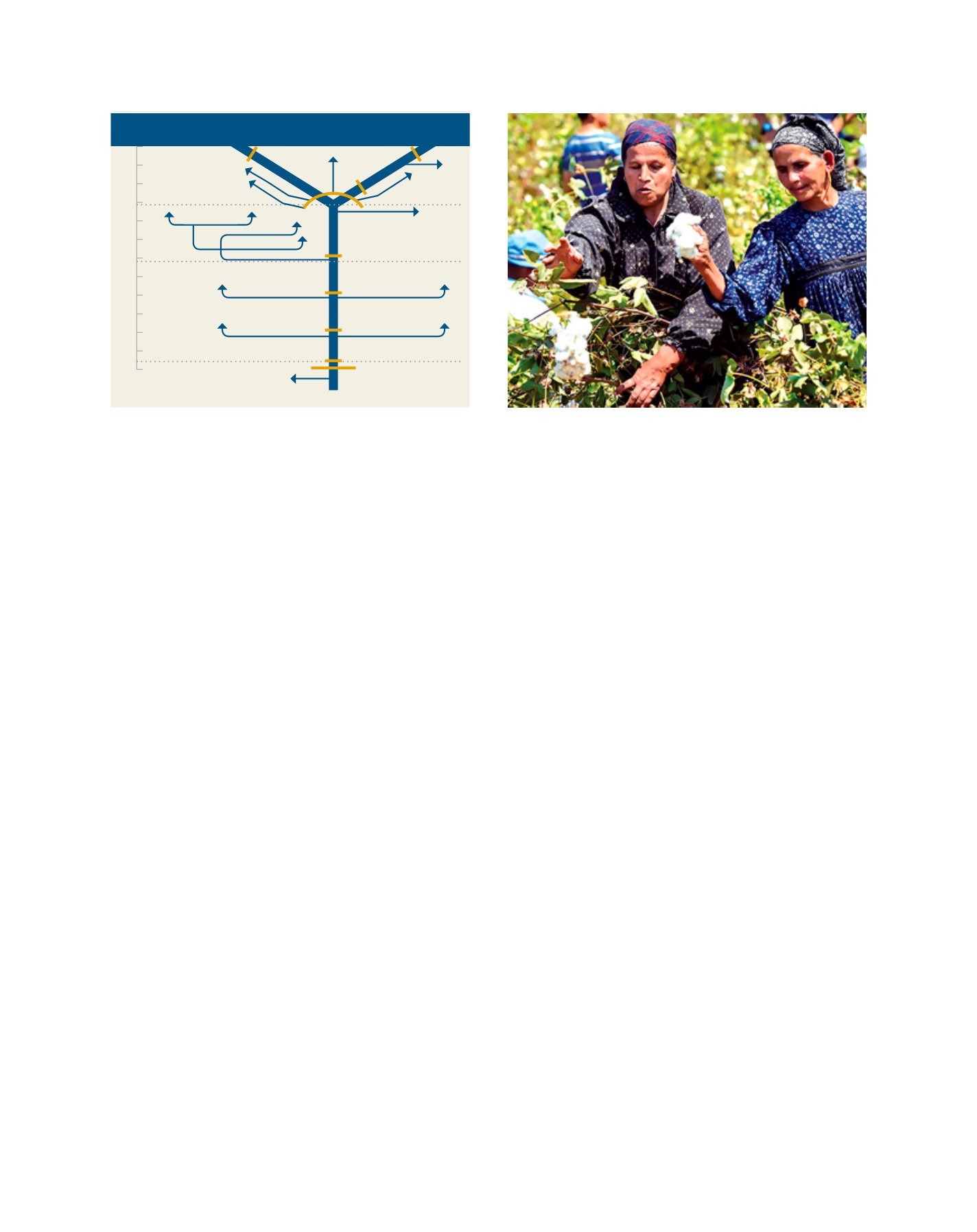

[
] 67
A B
et ter
W
or ld
by redesigning and lining canals; rain water harvesting;
research and development for low cost desalination tech-
niques; treated wastewater recycling; developing new water
resources through upper Nile projects; and developing new
species of crops to cultivate in high temperatures.
Adaptation options for coastal zones are highly site-
dependent. However, changes in land use, integrated coastal
zone management, and proactive planning for protecting
coastal zones are necessary adaptation policies. In this regard,
MWRI has developed a comprehensive master plan for reha-
bilitation and replacement of the major hydraulic structures
on the Nile and the main canals and rayahs, which distribute
water to large and medium-sized canals. New Esna and Naga
Hammadi barrages have been constructed, and work has
been underway in Assiut Barrage which will be fully opera-
tional by early 2018, while a tendering process is continuing
for the new Dairout group of regulators. Meanwhile, irriga-
tion improvement and IWRM projects have been developed
in the Nile Delta, with construction of flood protection works
totalling approximately £500 million between 2014 and 2016
and £700 million between 2017 and 2018.
Coastal flood protection works have been completed in
Rosetta, Baltim, Ras El Bar and Alexandria in addition to
the implementation of an integrated management plan for
the protection of Northern Lakes from sea level rise and salt
water intrusion. Moreover, public awareness is being raised
on the need for rationalising water use, enhancing precipita-
tion measurement networks and encouraging data exchange
among Nile Basin countries as well as developing regional
circulation models to predict the impact of climate change
on national and regional water resources.
Laws and rules governing the irrigation sector
The MWRI is the official authority in charge of develop-
ment, allocation and distribution of all conventional and
non-conventional water resources in the country. It is the
central institution for water quality management and for
formulating the national water policy for resolving the prob-
lems of water scarcity and water quality deterioration. Under
Law 12 (1984), MWRI retains overall responsibility for the
management of all water resources, including the available
surface water of the Nile system, irrigation water, drainage
water and groundwater. And for the empowerment of water
users, Irrigation Law 213 (1994) and Ministerial Decree 1490
(1995) were issued to supplement Law 12.
Law 9 (1962) was the first legislation to control the disposal
of wastewater in sewerage systems and water bodies. It was
followed by Law 48 (1982) created to control discharge of
wastewater into the Nile River and other water courses and
bodies. As the Egyptian government had become increas-
ingly aware of the importance of environmental protection
to sustain economic development, health and quality of life,
Law 4 (1994), which places an emphasis on the protection of
the coastal waters and the marine environment, was passed
to enable environmental conservation in a comprehensive
manner with the aim of achieving sustainable development.
In 1993, an environmental information system was set up
as an integral part of the Egyptian Environmental Affairs
Agency, with the capability to monitor water quality for the
purpose of pollution abatement and mitigation. A national
permit system for wastewater discharge and point of source
pollution from other sectors (municipal, energy, heavy
industry) has been put in place where authorised discharge
is monitored and controlled. In addition, norms have been
established for the usage of fertilisers, manure and pesticides.
Transboundary aspect
Egypt believes in the inevitability of cooperation between
the Nile Basin states in the utilisation of the basin’s water
resources. Egypt has participated in the establishment of the
existing institutional framework that governs the relations
between the riparian states. It also played a leading role in
establishing several cooperation initiatives, including the Nile
Basin Initiative (NBI) in 1999. In 2010, Egypt suspended its
participation in NBI activities in response to the non-consen-
sual decision taken by some upstream states to leave the draft
Cooperative Framework Agreement (CFA) open for signa-
ture. Egypt considers this unilateral decision to be a breach
of the NBI rules of procedure and of those of the negotiating
committee. Since then, the NBI has continued to function as a
Egyptian women working within the agriculture sector
Schematic of irrigation system in Egypt
Image: MWRI
200
100
000
900
800
700
600
500
400
300
200
100
0
Mediterranean Sea
Lower Egypt
Middle Egypt
Upper Egypt
Edifina Barrage
Dameitta Barrage
Zefta
Barrage
Assiut Barrage
Naga Hammadi Barrage
Esna Barrage
Behera Canal
Nasser Canal
Menoufia
Canal
Tawfiki Canal
Ismailia Canal
Ibrahimia Canal
Giza
Fayoum
Bahr
Yousef
Dairout
West Naga Hammadi Canal
East Naga Hammadi Canal
Asfoun Canal
km
Kelabia Canal
Toshka Project
Aswan Dam
High Dam
El-Salam
Canal
Source: national water resources plan (2017-2037)
















